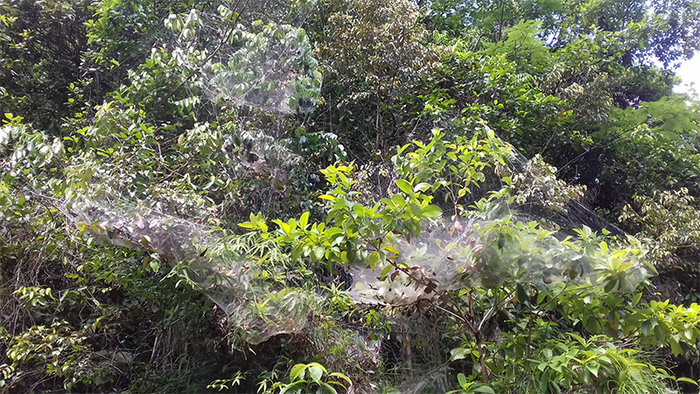Within the 50,000 known species of spiders about 20 have developed a permanent social life characterised by a remarkable cooperation1. Among these, one or two species hunt “in packs”, such as the Anelosimus eximius spiders of French Guyana, whose colonies can house several thousand individuals of all ages, coexisting peacefully in gigantic webs that often reach several cubic metres. When prey falls into their web, the spiders instantly adopt astonishing behaviour: synchronising their attack by coordinating phases of moving and stopping they strike as one. In this way, they are able to capture prey up to several hundred times their size. A team from the Centre de Recherches sur la Cognition Animale (CNRS/Université Toulouse III – Paul Sabatier)2 led by a CNRS researcher has just revealed the mechanisms at work in this unified hunt. By combining fieldwork and modelling, the team’s results identified the actions involved in the synchronisation of these movements. Synchronisation involves a modulation of each spider’s behaviour, according to the relative intensity of the prey’s signals compared to those of the other spiders: they remained motionless on the web just so long as the vibrations emitted by their fellow spiders masked those of the prey. This coordination increases their ability to detect prey and optimises their hunting performance. These results are published in the 7 March 2022 edition of the Proceedings of the National Academy of Sciences (PNAS).

Credit: © Raphaël Jeanson/CNRS
Within the 50,000 known species of spiders about 20 have developed a permanent social life characterised by a remarkable cooperation1. Among these, one or two species hunt “in packs”, such as the Anelosimus eximius spiders of French Guyana, whose colonies can house several thousand individuals of all ages, coexisting peacefully in gigantic webs that often reach several cubic metres. When prey falls into their web, the spiders instantly adopt astonishing behaviour: synchronising their attack by coordinating phases of moving and stopping they strike as one. In this way, they are able to capture prey up to several hundred times their size. A team from the Centre de Recherches sur la Cognition Animale (CNRS/Université Toulouse III – Paul Sabatier)2 led by a CNRS researcher has just revealed the mechanisms at work in this unified hunt. By combining fieldwork and modelling, the team’s results identified the actions involved in the synchronisation of these movements. Synchronisation involves a modulation of each spider’s behaviour, according to the relative intensity of the prey’s signals compared to those of the other spiders: they remained motionless on the web just so long as the vibrations emitted by their fellow spiders masked those of the prey. This coordination increases their ability to detect prey and optimises their hunting performance. These results are published in the 7 March 2022 edition of the Proceedings of the National Academy of Sciences (PNAS).
Notes
1- Present only in the tropics, these species have appeared independently several times during the course of evolution.
2- The CRCA is a member of the fédération de recherche Centre de Biologie Intégrative (CNRS/Université Toulouse III – Paul Sabatier)
Journal
Proceedings of the National Academy of Sciences
Method of Research
Computational simulation/modeling
Subject of Research
Animals
Article Title
A variable refractory period increases collective performance in noisy environments




